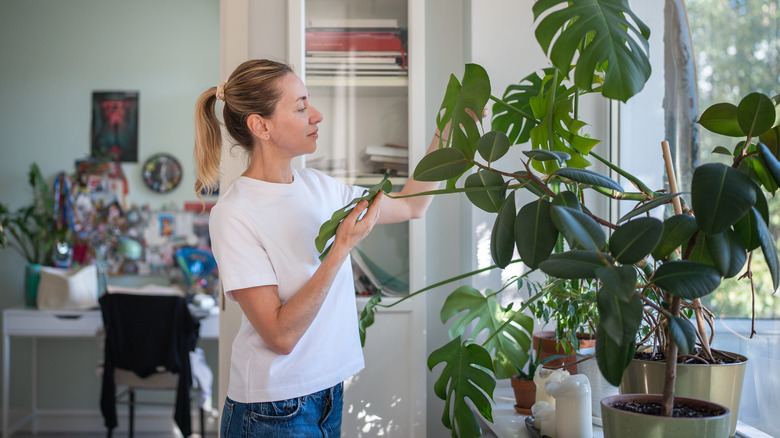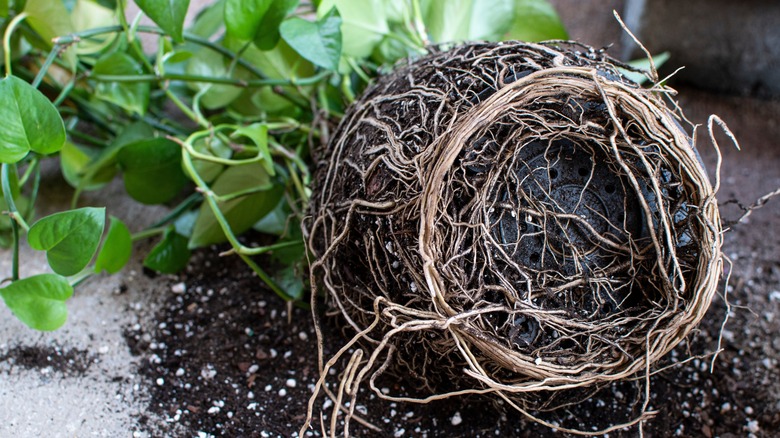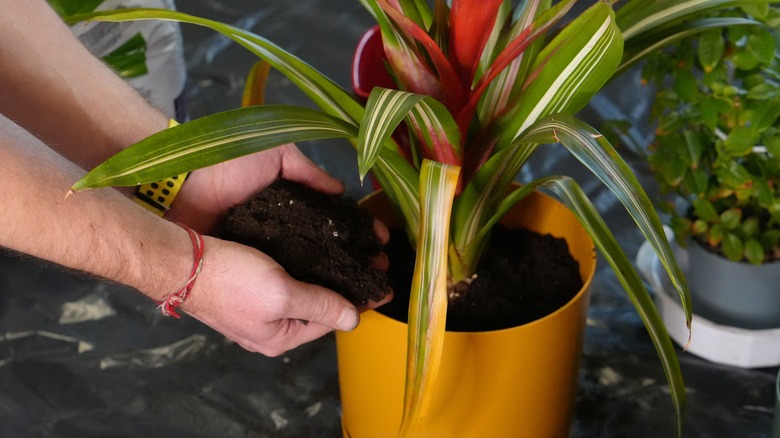The Major Factor To Consider Before Repotting An Indoor Houseplant
We all want to give our houseplants the best possible care, but sometimes we end up loving our leafy companions literally to death through too much attention — and that includes repotting too often. Although you might think you need to repot most of your houseplants once every year, it's better to examine your plants for clues as to their health, both above and under the soil. The roots, a typically hidden part of your plant's anatomy, provide perhaps the most vital signs on whether it's time to repot — or not. The need for repotting varies depending on what species of indoor plant you have and broader growing conditions. And both of these factors affect what's going on unseen beneath the soil.
Before you buy a new pot and bag of potting mix, remove your houseplant from its current container and look at the roots. You may discover that your plant has barely produced any roots to help it stabilize itself in its pot, especially if it was propagated from a cutting. Stability is an important factor for successful transplanting. Alternatively, the roots of a houseplant may be so entangled and cramped in their pot that they have become root bound. A root bound plant can sometimes be a positive, but more often than not, tangled roots are a sign that it's time to repot. Identification of root condition is important because the approach you take to repotting is a little different for either case.
How roots indicate that your indoor plant needs repotting
When an indoor plant has roots growing out of the top of the pot or emerging from the pot's drainage holes, consider these major signs that it's time to remove the plant from the container and check to see if it is root bound. When your favorite leafy companion is root bound, alternately called pot bound, its roots begin circling around and around in the pot. They may fill the container so completely that they push out most of the growing medium. A root bound houseplant is ready to be rehomed into a pot no more than 2 inches in diameter larger than the original so that it can continue to grow evenly.
On the other hand, if you un-pot your indoor plant and see a small, withered root ball, or if the pot is overly full of growing medium, the container is too large. Stunted root growth leads to stability issues; a top-heavy plant with excess leaf growth may topple over. The ideal houseplant pot has drainage holes and is just large enough to contain your plant's root ball. Growing houseplants in large pots that require a lot of soil to fill can overwhelm the roots and collect excess water, leading to root rot. The solution is downsizing to a smaller pot. Roots suffering from rot are mushy and discolored (black or brown instead of white), and should be removed before repotting.
When you should wait to repot a houseplant and what to do instead
Many container-grown plants only need repotting once every three to five years. Let's say one or two years have passed and your indoor plant seems to be growing well in its planter. If there's still room for its roots to spread, consider replacing some of the potting mix or other growing medium instead of repotting the plant.
Transplanting houseplants can shock them, and that's another good reason to wait to repot a houseplant that is neither cramped in its current pot nor swimming in too much soil or a planter that's too large. If in doubt, it's better to delay this care task to save your houseplant the unnecessary stress. If you've examined your plant's roots and can't decide whether to repot or not, other factors should come into play — for example, there are seasonal considerations. Should you repot houseplants during the winter? Waiting until early spring is best, when plants start actively growing again.


